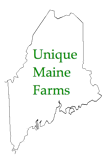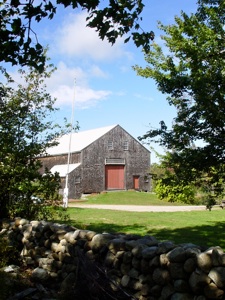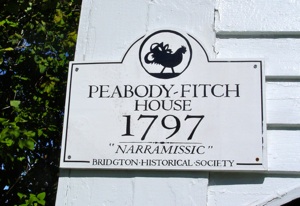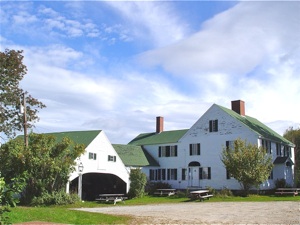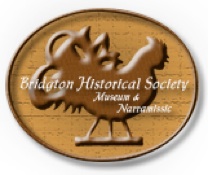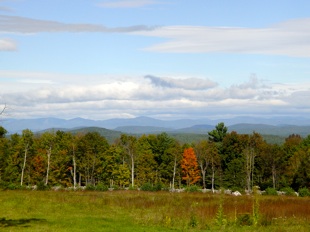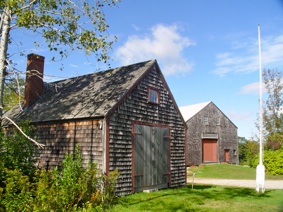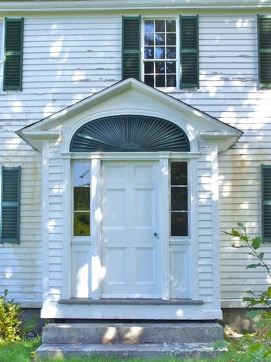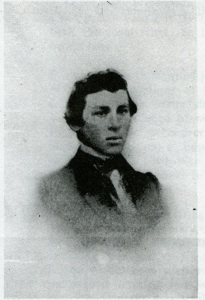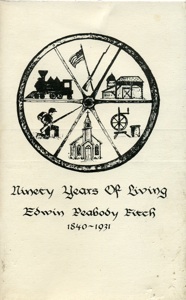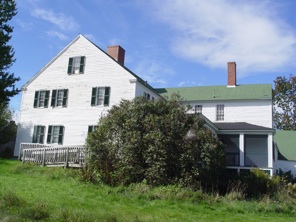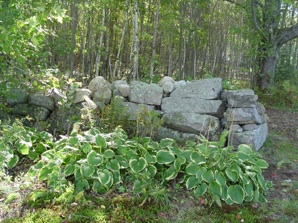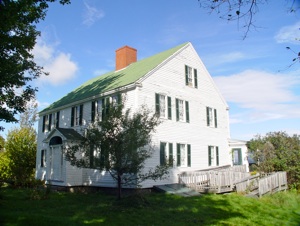Name: Narramissic Farm
Ingalls Road
Bridgton, Maine 04009
Contact Information:
Bridgton Historical Society
P.O. Box 44
Bridgton, Maine 04009
Phone: 207-647-3699
Email: info@bridgtonhistory.org
Website: www.bridgtonhistory.org
Facebook:
Facebook Page - Bridgton Historical Society
Products and Services:
-tours of the Peabody-Fitch House
-special events
-historic nineteenth century hilltop farm
-property of Bridgton Historical Society
-educational outreach
What Makes Narramissic Farm Unique?
The publication Ninety Years of Living that contains the memoirs of Edwin Peabody Fitch is less than one hundred pages, but it provides a wealth of information about what living on a farm in Maine in the mid 1800’s was all about.
It is unfortunate that Edwin died before he could finish sharing information about his life after returning from service in the Civil War and becoming a pioneer out west. The information that he was able to record truly is so valuable for those interested in a realistic account of farming in the early days of our state.
The Peabody-Fitch House was donated to the Bridgton Historical Society in 1986, by Mrs. Margaret Monroe of Providence, Rhode Island. She had used the house as a summer home for almost fifty years after purchasing it in 1938. According to the Bridgton Historical Society’s website, she named the house, “Narramissic,” after an Abenaki word that meant “hard to find.”
The Georgian style Peabody-Fitch House was built in 1797, by William Peabody. William’s daughter, Mary Peabody, and her husband, George Fitch, purchased the house in the 1830’s. George and Mary added an ell and a carriage house, and renovated the house in a Federalist style. They were the owners in the 1830’s, who were responsible for erecting the Temperance Barn and the blacksmith shop which are still situated on the property.
Edwin Peabody Fitch was the son of George and Mary. His children and grandchildren were the ones who encouraged him to write down his recollections when he reached ninety years of age. Edwin agreed to their requests and began a collection of letters which were placed in a publication that is still available for sale from the Bridgton Historical Society.
Edwin described how the family farm where he was raised was nearly self-supporting. He explained how his family basically only purchased tea, coffee, sugar, and salt. There was always enough to eat because they raised livestock, grew potatoes, and had plenty of apples.
The 210 acres of the Peabody-Fitch Farm were divided into tillage, pasture, and woodlands. There were two large apple orchards. Edwin’s reflection on apples was quite enjoyable. He wrote, “I shall never forget the apples, such apples as California will never have. To get perfect apples, they must grow in a country where there is snow several months a year and the soil contains clay and more or less of stone. These are the essentials necessary to the perfect apple and Maine has the right material.”
Baldwin apples were the ones that Edwin’s family frequently marketed. The fruit that the family raised and enjoyed included cherries, pears, grapes, and plums. The poorer-quality apples were brought to the Ingalls, their neighboring farm, where there was a cider mill set-up which crushed the apples into pulp.
All the meat consumed at the farm was acquired from the family’s livestock. Pigs, chickens, milk cows, geese, and sheep were raised. The sheep were also a source of wool for their clothing. Edwin and his siblings cleaned the wool before it was sent to a carding mill. It was returned in rolls and a pipe-smoking woman by the name of Aunt Betsy Ford arrived each year for two weeks to spin the rolls into yarn. Edwin’s mother, Mary Peabody Fitch, was an experienced weaver who made clothes for all nine members of the family. Mary and Edwin’s sisters were also kept busy with the knitting of the socks and mittens.
Mary Peabody had been born in the house where Edwin was born and raised. It was a large house with “monster chimneys” with six fireplaces. The beans and brown bread were baked in the immense oven in the chimney. The Peabody-Fitch family grew wheat and they took the wheat to the mill to be ground into flour. There was a “meal room” in the house where the flour and cornmeal were stored.
In the twenty-first century so much is often taken for granted. An electrical switch is flicked and the room is lit. When Edwin lived at the farm the family counted on the candles that they made and the whale oil in the lamps for their illumination. Transportation involved walking or hitching up the horse.
Oxen played a significant role at the farm. Most of the farm work was provided by the oxen and the horses. The sixteen foot hay rack used for hauling the hay required the use of oxen. There were no riding plows at the time, so the fields were tended by an individual walking behind the farm equipment that was pulled by either oxen or horses.
The hay was cut by hand with a scythe and raked by hand. Edwin explained that during haying time it usually meant sixteen-hour days. A threshing machine was transported to the farm with a two-horse team. It was followed by a light wagon with a fanning mill on top.
While all the work that Edwin described appears somewhat overwhelming, it was tempered by the fact that community gatherings and holiday celebrations were greatly enjoyed. Each May Day there would be May Pole dancing. While the corn was being husked, festive gatherings were planned with dancing and refreshments.
Thanks to the efforts of the Bridgton Historical Society, special events continue to take place at the Peabody-Fitch property. Many visitors have been drawn to its magnificent views and peaceful setting. There have been weddings, bluegrass concerts, company outings, family reunions, bridal showers, artisan festivals, dances, blacksmith demonstrations, lectures, and courses.
The Peabody-Fitch House offers a wonderful view of life in Maine on a hilltop farm prior to the Civil War. Edwin Fitch shared a great deal of information in his Memoirs about his participation and imprisonment in the Civil War so the booklet would provide an informative read for those who have an interest in this time period. Narramissic was placed on the National Register of Historic Places in 1989.
Unfortunately, the 40 x 60 foot Temperance Barn at Narramissic was recently placed on “Maine’s Most Endangered Historic Resources” list by Maine Preservation. The barn structure has shifted from its foundations. It was built in the 1830’s by George Fitch and interestingly was known as the Temperance Barn because, upon conclusion of being built, the customary barrel of rum was not offered in celebration, as was so often the tradition of a barn-raising at the time.
The Bridgton Historical Society is in the early stages of planning the restoration and fundraising campaign for the Temperance Barn. A wonderful video about the barn was created by Don Perkins, author of The Barns of Maine: Our History, Our Stories, and it can be viewed on youtube.
When the winter weather of 2014 finally makes it departure, Unique Maine Farms plans on returning to Narramissic to photograph the interior of the Peabody-Fitch home and the blacksmith shop. It is hoped that visitors to the Unique Maine Farms’ website will return to check out the newly-added photos and perhaps
plan an outing to Narramissic themselves!


